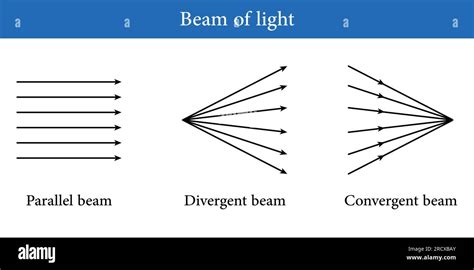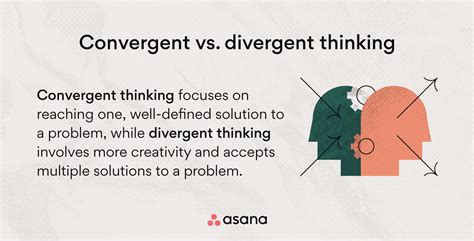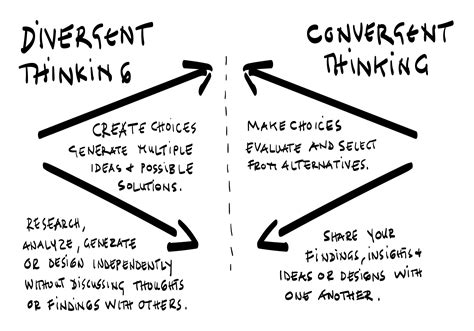The terms convergent and divergent have been used in various contexts, including mathematics, psychology, and education, to describe two fundamentally different approaches to thinking, problem-solving, and learning. Convergent thinking involves a systematic and logical approach to problem-solving, where an individual uses existing knowledge and rules to arrive at a single, correct solution. In contrast, divergent thinking is a more flexible and creative approach, where an individual generates a wide range of possible solutions to a problem, often without a clear right or wrong answer.
Convergent thinking is often associated with traditional education, where students are taught to follow established rules and procedures to solve problems. This approach is useful for developing critical thinking skills, such as analysis and evaluation, and for solving well-defined problems with a clear solution. However, convergent thinking can also be limiting, as it may not allow for the exploration of new ideas or the consideration of alternative perspectives. For example, in a mathematics class, a student may be asked to solve a linear equation using a specific formula, without being encouraged to think about the underlying principles or to consider alternative methods.
Key Points
- Convergent thinking involves a systematic and logical approach to problem-solving, with a focus on arriving at a single, correct solution.
- Divergent thinking is a more flexible and creative approach, where an individual generates a wide range of possible solutions to a problem.
- Convergent thinking is useful for developing critical thinking skills, such as analysis and evaluation, and for solving well-defined problems.
- Divergent thinking is useful for generating new ideas, exploring alternative perspectives, and solving complex, ill-defined problems.
- A balanced approach that combines both convergent and divergent thinking is often the most effective way to solve complex problems and to develop creative and critical thinking skills.
Convergent Thinking in Practice

Convergent thinking is commonly used in a variety of contexts, including science, technology, engineering, and mathematics (STEM) fields, where problems often have a clear solution. For example, in a physics class, a student may be asked to calculate the force of gravity acting on an object, using a specific formula and given values. This type of problem requires convergent thinking, as the student must use established rules and procedures to arrive at a single, correct solution.
However, convergent thinking can also be limiting, as it may not allow for the exploration of new ideas or the consideration of alternative perspectives. For example, in a business setting, a manager may use convergent thinking to develop a marketing plan, by following established procedures and using data from previous campaigns. While this approach may be effective in the short term, it may not allow for the consideration of new ideas or the exploration of alternative strategies.
Divergent Thinking in Practice
Divergent thinking, on the other hand, is a more flexible and creative approach to problem-solving, where an individual generates a wide range of possible solutions to a problem. This approach is often used in art, design, and other creative fields, where there is no single “right” answer. For example, in a graphic design class, a student may be asked to create a logo for a new company, using a variety of colors, shapes, and fonts. This type of problem requires divergent thinking, as the student must generate a wide range of possible solutions, without being limited by established rules or procedures.
Divergent thinking is also useful for solving complex, ill-defined problems, where there is no clear solution. For example, in a environmental science class, a student may be asked to develop a plan to reduce carbon emissions in a local community. This type of problem requires divergent thinking, as the student must consider a wide range of possible solutions, including alternative energy sources, transportation systems, and waste management strategies.
| Thinking Style | Characteristics | Examples |
|---|---|---|
| Convergent | Systematic, logical, rule-based | Mathematics, science, engineering |
| Divergent | Flexible, creative, open-ended | Art, design, creative writing |

Implications for Education and Professional Development

The distinction between convergent and divergent thinking has important implications for education and professional development. Traditional education often emphasizes convergent thinking, with a focus on developing critical thinking skills, such as analysis and evaluation. However, this approach can be limiting, as it may not allow for the exploration of new ideas or the consideration of alternative perspectives.
In contrast, a more balanced approach that combines both convergent and divergent thinking can help individuals develop a more comprehensive and innovative approach to problem-solving. This approach can be particularly useful in professional development, where individuals are often faced with complex, ill-defined problems that require creative and critical thinking skills.
Strategies for Developing Convergent and Divergent Thinking
There are several strategies that can be used to develop convergent and divergent thinking skills. For convergent thinking, individuals can practice solving well-defined problems, using established rules and procedures. This can help develop critical thinking skills, such as analysis and evaluation.
For divergent thinking, individuals can practice generating new ideas and exploring alternative perspectives. This can be done through brainstorming, mind mapping, and other creative techniques. Additionally, individuals can seek out diverse perspectives and experiences, such as traveling, reading, and engaging in conversations with people from different backgrounds.
What is the difference between convergent and divergent thinking?
+Convergent thinking involves a systematic and logical approach to problem-solving, with a focus on arriving at a single, correct solution. Divergent thinking, on the other hand, is a more flexible and creative approach, where an individual generates a wide range of possible solutions to a problem.
How can I develop convergent thinking skills?
+You can develop convergent thinking skills by practicing solving well-defined problems, using established rules and procedures. This can help develop critical thinking skills, such as analysis and evaluation.
How can I develop divergent thinking skills?
+You can develop divergent thinking skills by practicing generating new ideas and exploring alternative perspectives. This can be done through brainstorming, mind mapping, and other creative techniques. Additionally, you can seek out diverse perspectives and experiences, such as traveling, reading, and engaging in conversations with people from different backgrounds.
In conclusion, the distinction between convergent and divergent thinking is an important one, with implications for education, professional development, and personal growth. By understanding the characteristics of each thinking style and developing strategies for using them effectively, individuals can become more effective problem-solvers and develop a more comprehensive and innovative approach to learning and professional development.
As we move forward in an increasingly complex and interconnected world, the ability to think creatively and critically will become increasingly important. By developing a balanced approach that combines both convergent and divergent thinking, individuals can stay ahead of the curve and achieve their goals in a rapidly changing environment.
